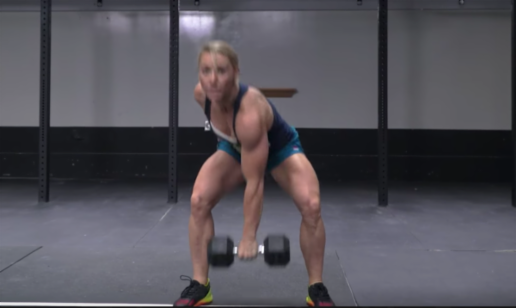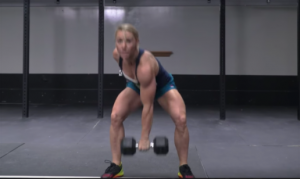
Last week I stopped by to visit at a friend at Invictus (Crossfit) in San Diego and it just happened to be the first Friday night of the CF Open so naturally I got to watch a bunch of freakshow athletes suffer through something you couldn’t pay me any price to do.
And it got me thinking about something with regards to resilience and injury.
One of the movements in this open WOD was the one-arm dumbbell snatch, naturally for high reps. Now you might look at this (combined with burpees and box jumps) and you might think man that is a great way to jack up a back.
Yet I have been paying attention to open workouts for many years now, and through observing trends on Facebook I can see which ones are jacking people up and which ones (sometimes surprisingly) aren’t.
And this one isn’t.
Why? And how does it relate to the deadlift?
Well first of all you have to recognize that the dumbbell snatch is basically a one-arm deadlift done with a light weight and brisk movement. It’s nothing like a barbell snatch, and with the light weight done for high reps it’s simply a hip-dominant movement with minimal knee bend done explosively. In other words a deadlift.
And it doesn’t jack up peoples backs because it’s asymmetrical.
Perfectly symmetrical movements force a body that is not symmetrical (in the vast majority of people) into a position of symmetry that is not natural to begin with, and then there’s no room to move or to move away from tension or stress because of the symmetry. Check out this screen cap:

All that rotation and asymmetry allows the body to involve more tissue and more variability in the movement. Sure there’s some rotation in the spine, but it’s ok for the spine to move like that. What little risk there is in rotation is more than offset by the fact that there is so much more tissue involved to bear the stress of the movement.
So what’s the takeaway?
Don’t be afraid to stagger your position or otherwise introduce asymmetry. One of the places I always start when I’m nursing someone back to health after a back injury is with asymmetrical deadlifts because they are almost universally well tolerated. Not so for conventional symmetry. This is why I’m such a fan of asymmetrical deadlift options like the Jefferson.
Even if you don’t have any issues, I’ll wager that it’ll feel better with a bit of asymmetry. Ideally, you can always test and find the best option with biofeedback.


Leave a Reply